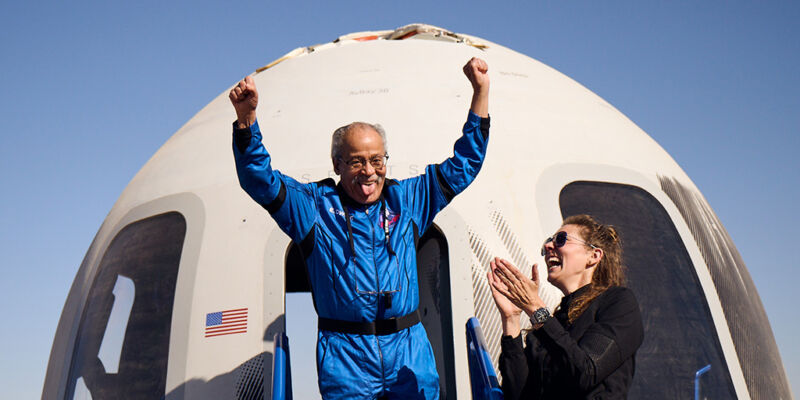
More than 60 years after being denied the chance to become America’s first black astronaut, Ed Dwight finally traveled into space Sunday with five other passengers for a 10-minute flight aboard a Blue Origin capsule.
Dwight, a retired Air Force captain and test pilot, had the chance to become the first African-American astronaut. He was one of 26 pilots the Air Force recommended to NASA for the third class of astronauts in 1963, but the agency did not select him. It took another 20 years for the first black American astronaut, Guion Bluford, to fly into space in 1983.
“Everything they did, I did and I did it well,” Dwight said in a video released by Blue Origin. “If the policy had changed, I would have gone to space in some capacity.”
At the age of 90, Dwight finally entered the record books on Sunday, becoming the oldest person to reach space, displacing the previous record holder, actor William Shatner, who flew on a Blue Origin’s similar launch to the far reaches of space in 2021.
“I thought I didn’t need it in my life,” Dwight said after Sunday’s fight. “But I lied!”
Since retiring from the Air Force, Dwight has become an accomplished sculptor. His works, focused on black history, are installed in memorials and monuments across the country.
“The transitions and separations and everything else were a little more dynamic than I thought,” Dwight said after Sunday’s flight. “But that’s how it’s supposed to be. It makes you wonder, ‘Is something wrong?’ But no, it was absolutely amazing and the view…absolutely fantastic. This was a life-changing experience for me. Everyone has to do this.

Dwight and his five co-passengers took off from Blue Origin’s remote launch site in West Texas at 9:35 a.m. CDT (2:35 p.m. UTC). Strapped into reclining seats inside a pressurized capsule, passengers flew Blue Origin’s New Shepard rocket into the highest layers of the atmosphere. After burning its main engine for more than two minutes, the rocket released the crew capsule and continued on its way to an apogee, or high point, of nearly 66 miles (107 kilometers), just above the internationally recognized limit of space.
It was the seventh time that Blue Origin, the space company owned by billionaire Jeff Bezos, had sent people into suborbital space, and the 25th flight overall of the company’s fleet of New Shepard rockets. It was the first time Blue Origin launched humans in nearly two years, resuming suborbital service after a rocket failure during an uncrewed research flight in September 2022. In December, Blue Origin launched another mission uncrewed suborbital research to prepare the ground for the resumption of human missions on Sunday.
Joining Dwight on the Blue Origin capsule were investor Mason Angel, French businessman Sylvain Chiron, software engineer Kenneth Hess, adventurer Carol Schaller and Indian pilot and entrepreneur Gopi Thotakura. Dwight’s ticket with Blue Origin was sponsored by Space for Humanity, a nonprofit organization that seeks to expand access to space for all, and the other five participants were paying passengers.
After the New Shepard rocket’s engine shut down, passengers were given a few minutes to unbuckle their seat belts and float around the cabin while admiring views of Earth. They returned to their places as the capsule descended into the atmosphere. The New Shepard reusable booster reignited its main engine for a propulsive landing in Texas, while the crew capsule deployed parachutes to slow down before landing a few miles away.
Two out of three
However, one of the three main parachutes did not fully deploy as the capsule fell back toward the ground. The capsule is designed to land safely with two drops, a capability demonstrated by Blue Origin during a 2016 test flight.
“It looks like we have two parachutes fully inflated, the third one is not fully inflated,” said Ariane Cornell, a Blue Origin official hosting the company’s live webcast Sunday. “Landing with two parachutes is perfectly acceptable for this system.”
Family members and Blue Origin staff greeted passengers as they exited the capsule. All six seemed in good spirits and in good health.
While this had no obvious negative effects on the crew or the spacecraft, Blue Origin engineers will investigate the malfunction to determine what went wrong. The capsule’s three main parachutes were supplied to Blue Origin by Airborne Systems, which makes parachutes for every human-capable U.S. spacecraft.

Blue origin
Airborne also supplies parachutes for SpaceX’s Dragon spacecraft, Boeing’s Starliner and NASA’s Orion capsule. These parachutes have different designs and sizes than the chutes used on Blue Origin’s capsule, but it was not immediately clear whether there could be crossover issues on other programs resulting from the malfunction during the Sunday flight.
The Federal Aviation Administration, the regulatory agency that oversees U.S. commercial space missions, said in a statement that it did not view the parachute issue as a misadventure. This statement suggests the incident will not trigger an accident investigation that would require FAA oversight.
Before the 2022 launch failure, Blue Origin’s New Shepard program averaged a cadence of about one flight every two months. Virgin Galactic, the space tourism company founded by Richard Branson, increased the flight cadence of its SpaceShipTwo suborbital spaceplane over the last year while Blue Origin’s rocket remained grounded.
But Virgin Galactic is set to shut down operations of its own spacecraft after an additional flight with passengers next month. The company says it has decided to suspend VSS flights Unit rocket plane to focus its resources on developing a fleet of larger, more easily reusable spacecraft.
This means that Blue Origin, assuming it can regain or build on the cadence demonstrated in 2021 and 2022, will be the only company serving the suborbital space tourism and research market for at least the next two years.